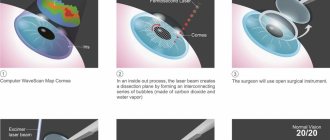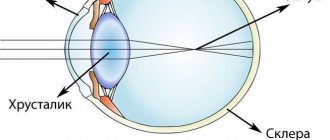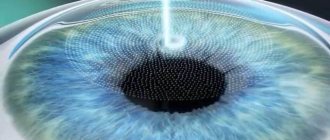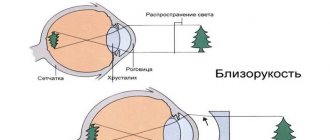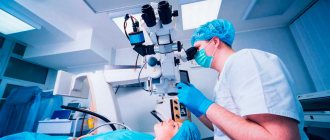- Types of operations and indications
- Anterior radial keratotomy
- Myopic keratomileusis
- Excimer laser correction
- Clear lens removal
- Patient reviews
- Operation price
- Video
Myopia or myopia is the most common visual impairment. The incidence of this pathology is steadily increasing every year throughout the world. People with myopia have difficulty visually analyzing objects located at a distance. At the same time, such near activities as reading and working on a computer are not difficult. Other manifestations of myopia include headaches and eye strain. People with uncorrected myopia report constant fatigue after driving or playing sports.
Myopia occurs when the length of the eyeball is too long in relation to the refractive power of the cornea and lens, or due to irregular curvature of the cornea or lens, or due to a combination of these factors. As a result, light rays are focused in front of the retina, and not on its surface, which is manifested in the patient by a decrease in distance visual acuity. The typical manifestation of the disease is in childhood and, as a rule, progresses until a person reaches adulthood.
Types of operations and indications for surgical correction
Modern ophthalmological microsurgery has a large arsenal of surgical interventions to correct myopia. There are no absolute indications for such operations. Of primary importance is the patient's desire to see well without glasses or contact lenses.
In this article we will consider the following types of operations to correct myopia:
- Anterior radial keratotomy . Its essence lies in the mechanical removal of part of the cornea to change its refractive power in order to more correctly focus light rays on the retina. The best results after such an operation are achieved in patients with myopia from 1.5 to 6.0 diopters. For patients with readings less than 1.5 diopters, such manipulation is not recommended due to the risks of excessive correction. If the threshold of 6.0 diopters is exceeded, the probability of obtaining an acceptable result is low. For people under the age of 21, radial keratotomy is not performed due to unstable refractive indexes. People whose expected correction level with glasses does not reach 20/40 rarely undergo this operation. We are talking about patients with amblyopia, maculopathy, myopia with a history of retinal detachment, as well as macular degeneration.
- Myopic keratomileusis . The indication is myopia over 6 diopters. The essence is to form a flap, after bending which part of the corneal stroma is removed. Before such an operation, a comprehensive examination of the organ of vision is necessary, including measurement of the thickness of the cornea. Age restrictions are the same as in the previous paragraph.
- Excimer laser correction involves changing the shape of the cornea using laser exposure. Instead of being removed by surgical instruments, the corneal stroma is vaporized by laser beams. This method has proven itself to be effective in correcting myopia up to 6.0 diopters.
- Removal of the clear lens is the operation of choice for patients with a high degree of myopia (10 diopters and above), as well as when it is impossible to perform surgery on the cornea due to its insufficient thickness. In order to change the refraction, the patient's own unchanged lens is removed, and an artificial lens with the required optical power is installed in its place.
Optimal age to start myopia correction
In principle, the treatment of myopia does not imply a special age limit - it should be treated as soon as it is detected. It is detected more often in children aged 7-12 years due to increased visual load during the learning process, but it can also be detected at a younger age - 0-6 years. In such cases, the causes of myopia are congenital pathologies - too large an eyeball, various diseases, etc. As a rule, they are the result of intrauterine infections, failures in the formation of the optical system or heredity and require longer-term treatment.
Moreover, if myopia progresses by more than 1 D per year, regardless of the cause, it is called progressive. This is a fairly serious disease that impairs a person’s ability to work and limits the choice of work. Therefore, it is so important to identify and correct myopia from early childhood. It is believed that it is advisable to treat it until about 25 years of age, since then it stops progressing.
It has been noted that myopia can progress even after the age of 25 - again, due to increased stress. Therefore, it is not recommended to abandon treatment and prevention.
Hardware techniques
Treatment and prevention of myopia in childhood is carried out comprehensively: optical correction, drug therapy and hardware treatment. The latter is aimed at improving accommodation, training the eye muscles and improving visual acuity. And also to prevent the development of amblyopia and strabismus.
Hardware methods include:
- Vacuum and vibration massage (warming up the eye muscles before treatment with the device).
- Color pulse therapy (emotional stress relief).
- Macular stimulation (stimulation of areas of the brain responsible for vision).
- Video-computer, electrical, laser stimulation (increasing visual capabilities, stabilizing myopia, relieving tension in the eye muscles).
- Electrophoresis and more.
As a rule, they do not have a special effect on the degree of myopia - treatment with devices is effective for low degrees (up to -2 D). At higher levels, vision is simply maintained at the existing level, preventing the disease from progressing.
Anterior radial keratotomy
Doctors became interested in surgical correction of myopia by direct action on the cornea at the end of the 19th century. However, radial keratotomy became the most commonly performed refractive surgical procedure in the late 1970s and early 1980s. The pioneer in this field was the Soviet ophthalmologist Svyatoslav Nikolaevich Fedorov. During the 1980s, hundreds of thousands of such interventions were carried out around the world. With the development of laser technologies - photorefractive keratotomy and LASIK, keratotomy is performed very rarely and only for certain indications.
Myopia reduction during this operation is achieved by flattening the cornea. Thus, its refractive power is reduced, and light rays begin to focus precisely on the retina. Thanks to this, vision improves.
Anesthesia during surgery is local - eye drops with an anesthetic; very rarely additional intravenous sedation is required. Before the operation begins, the surgeon marks an area in the central part of the cornea, called the optical zone. This area always remains intact - no incisions are made on it. The surgeon also decides on the depth of the incisions depending on the thickness of the cornea. A special diamond scalpel with a dosed blade is used to make 4-12 radial incisions on the periphery of the cornea, depending on the degree of myopia. As it heals, due to intraocular pressure, the cornea flattens, which contributes to a change in the degree of refraction. The operation is performed under the control of a surgical microscope. Duration is 30-40 minutes.
After the local anesthetic wears off, the patient may experience pain, for the relief of which it is advisable to use painkillers (analgin, baralgin, ketoral and their analogues) or ocular anesthetics. Antibiotic drops are also prescribed in the postoperative period to prevent infection. The cornea does not heal very quickly after such an operation; complete recovery takes several months. As the patient recovers, he or she may encounter the following problems:
- Variability of acuity - vision may be better in the morning and worse in the evening.
- Periodic pain syndrome.
- The appearance of a halo of radiance around light sources at night.
- Hypercorrection - changes in refraction towards farsightedness, the so-called hypermetropic shift. As the cornea flattens, the patient may experience hypermetropia. This is why the surgeon initially performs incomplete correction.
The following complications occur after radial keratotomy:
- Clouding of the lens and formation of cataracts.
- Severe infectious processes - uveitis, endophthalmitis.
- Severe scarring leading to clouding of the cornea.
- High risk of corneal rupture due to keratotomy scars due to injury to the eyeball.
Myopic keratomileusis
Keratomileusis is a surgical method to improve the refractive power of the cornea. The essence of the technique is to separate the thin surface layer of the cornea using a microkeratome. A corneal flap is formed, which is moved aside for the duration of the intervention, thereby providing access to the middle layers of the cornea. Using surgical instruments, a part of the corneal stroma is cut out, as a result of which the corneal profile changes, which contributes to the correction of myopia. After flattening the cornea, the formed flap is returned to its place and sewn with a continuous suture.
The intervention is performed under local anesthesia. In the postoperative period, it is necessary to avoid injury to the eyes and do not rub them. In case of excessive insolation, use sunglasses. The recovery period lasts up to six months. The complications listed in the previous section of the article may develop.
Excimer laser correction of myopia
The widespread introduction of the excimer laser into ophthalmological practice has made it possible to quickly, painlessly and effectively carry out various interventions, including the correction of myopia. Laser radiation hitting the cornea is transformed into thermal energy. In this case, a local increase in temperature and evaporation of tissue occurs - ablation, without any negative impact on surrounding tissue. Excimer laser vision correction is currently the most advanced and highly accurate method of myopia correction with a minimum number of possible complications. In the daily practice of an ophthalmic surgeon, two excimer laser correction technologies are most widely used: PRK and LASIK.
The eyelids are fixed using an eyelid speculum to prevent unwanted blinking during surgery. The area to be removed is marked using a computer. During the operation, the patient is asked to fix his gaze on the red dot. Local anesthesia - drops with a local anesthetic. The operation is performed on an outpatient basis, the operation duration is 15-20 minutes for both eyes.
After the local anesthetic wears off, the patient may experience severe itching or burning. It is important not to rub or injure the operated eye under any circumstances. During the first 24 hours, lacrimation and redness are possible, but gradually these symptoms go away. A feeling of excessive dryness is acceptable for a month. For this purpose, artificial tears are prescribed 3-4 times a day. During this period, it is advisable to limit physical exercise, swimming, and not use eye makeup for 2-3 weeks. Vision is restored gradually. The timing is individual - from 1 to 3-4 months.
How to improve vision with myopia: useful tips
- Drink 100 grams every morning on an empty stomach. freshly squeezed carrot juice. - Take vitamin A both in capsules and in natural form.
- Introduce berries (strawberries and blueberries), citrus fruits, parsley and dairy products into your diet.
- Try to read less (especially while lying down or in transport) and watch TV. If your work involves a computer, do not forget to take a break every half hour, during which you do gymnastics or just sit with your eyes closed.
- Leave at least a low light on while watching TV. The TV itself should be located as far away as possible. To be absolutely precise, the distance between you and the device should be a full five times the diagonal size of the screen.
- Spend more time in the fresh air (walking norm for children is 2 hours, for adults - 1 hour). - Give up the habit of reading before bed. The fact is that the eyes do not have time to relax, and even if you soon fall asleep, they still continue to work.
- When working with small objects or drawings, make sure they are well lit.
We advise you to read the article Chalazion - treatment, causes, in order to be fully prepared if this disease occurs.
You can find out about the necessary vitamins for the eyes for myopia here: https://viewangle.net/bol/blizoruk/vitaminy-dlya-glaz-pri-blizorukosti.html
ULP (clear lens removal)
This operation is performed for those patients who, for various reasons, cannot undergo excimer laser correction of myopia. The surgical intervention lasts 15-20 minutes and is similar to that for cataract removal. Under local anesthesia, a microscopic puncture of the cornea is performed to insert instruments into the eye cavity. A circular excision of the anterior lens capsule is performed. Then the lens substance is crushed under the influence of ultrasound to a suspension using a phaco needle. The resulting detritus is removed from the eye through aspiration. The posterior capsule remains intact - it is used for correct and stable fixation of the intraocular lens. An intraocular lens or artificial lens is inserted into the eye using an injector and fixed in the capsular bag.
Depending on the degree of myopia and the desired postoperative result, several types of artificial lenses are used:
- Monofocal - provide vision either near or at a distance, do not have the ability to accommodate. Used in combination with glasses or contact lenses.
- Multifocal – provide good vision at various distances.
- Accommodating lenses are a type of monofocal lens. Good vision at different distances is achieved by changing the position of the artificial lens inside the eye.
At the end of the operation, no stitches are applied, since the surgical puncture is self-sealing. Due to the minimally invasive nature of the operation, hospitalization is not required; the patient can leave the clinic on the day of the operation. The postoperative period does not differ from that with other methods of myopia correction.
Surgery to remove the clear lens for myopia is more traumatic compared to laser correction of myopia, but is an option when excimer laser surgery is contraindicated.
Correction with contact lenses
Contact lenses are an improved method of spectacle therapy. This is a more modern method of maintaining normal vision. Just like glasses, contact lenses have a number of advantages and disadvantages. Among the advantages, it should be noted the possibility of using lateral vision. And this is extremely important, especially for professions such as a driver. If you use contact lenses, you can engage in active sports. After all, the lenses do not interfere at all. Additionally, many people may not even realize that you have vision problems. Today, a huge number of corrective contact lenses are produced, so you can even choose colored options. Among the disadvantages it is important to note the following:
- Contact lenses often cause irritation and inflammation of the conjunctiva. Therefore, they cannot be worn for a long time.
- Every day you will have to put them in and take them out again. It is important to observe hygiene standards. That is, lenses must be stored in special packaging and always be clean. To do this, they are treated with special liquids.
- Compared to glasses, lenses are more expensive.
- There is a risk of developing ophthalmic diseases. For example, corneal erosion, which occurs due to lens rupture and damage during putting on or taking off.
- Dry eye syndrome occurs quite often, as contact lenses excessively dry out the mucous membranes of the eyes. Due to the lenses, hypoxia develops, that is, a lack of oxygen, which in turn leads to swelling of the cornea. Infection occurs when hygiene measures are not observed correctly. Sometimes conjunctivitis develops in the follicular form.
Patient reviews
Patients who decide to undergo surgical correction of myopia are generally satisfied with the results and leave positive reviews. Such operations help people get rid of glasses and contact lenses forever and not experience discomfort when driving.
During recovery, complications may develop and healing time may be prolonged. All patients are warned in advance about the likelihood of such a scenario. Some patients report severe discomfort in the postoperative period - pain, itching, redness of the eye and dryness. All these symptoms are temporary. If all the specialist’s recommendations are followed and the operated eye is properly cared for, patients quickly return to comfortable everyday life.
Operation price
| Service | price | |
| code | Name | |
| 20.06 Laser vision correction (for one eye) | ||
| 2006001 | LASIK/Super LASIK for myopia and hypermetropia | 26500 |
| 2006002 | LASIK/Super LASIK for myopia and hypermetropia with astigmatism | 28500 |
| 2006003 | LASIK/Super LASIK for mixed astigmatism | 32500 |
| 2006004 | LASIK Super Vision | 36000 |
| 2006005 | Additional correction after operations performed in other clinics | 38000 |
| 2006006 | Photorefractive keratectomy | 17500 |
| 2006007 | LASIK/Super LASIK, professor, MD. | 44000 |
| 2006008 | Operation Super-Lasik (promotion, for both eyes) | 32000 |
| 2006010 | Laser vision correction (promotion, for both eyes) | 35000 |
| 2006011 | LASIK/Super LASIK for mixed astigmatism | 35000 |
The operations described in the article to correct myopia are considered cosmetic, are performed strictly at the request of the patient and, accordingly, cannot be free. Radial keratotomy and surgical keratomileusis are currently rarely performed due to the traumatic nature and active use of laser methods. The price of radial keratotomy varies between 10,000 – 35,000 rubles.
Laser myopia correction is the most popular. Its cost depends on the category of complexity and type of operation. The cost of surgery for one eye ranges from 30,000 to 50,000 rubles. Lens replacement is a more expensive operation - from 50,000 to 100,000 rubles, depending on the category of complexity and the model of the artificial lens. The intraocular lens can be included in the final price of the operation or paid separately. Premium segment lenses are always paid separately, since the price of a multifocal or accommodating artificial lens, depending on the manufacturer, varies from 25,000 rubles to 65,000 rubles.
Surgeries to correct myopia do not lose their relevance. Modern eye microsurgery technologies allow people to forget about glasses, contact lenses and visual discomfort.
Modern correction methods
Despite extensive clinical experience, the treatment of myopia continues to remain one of the most difficult areas in ophthalmology. Modern medicine offers a wide range of possibilities and methods for correcting vision for myopia: from glasses known since the 18th century to the latest technologies. But, for their most effective use, it is important to determine the causes and type of myopia, as well as take into account many other associated factors.
Treatment methods for myopia include:
- wearing glasses;
- wearing contact lenses of various types;
- drug therapy;
- hardware therapy;
- therapeutic exercises for the eyes;
- laser correction;
- keratoplasty;
- eye lens replacement;
- radial keratotomy.
Each method has its pros and cons, indications and contraindications, almost all have the possibility of various complications. But they have the same goal - to correct vision, that is, to change the optical system so that the image is focused correctly.

